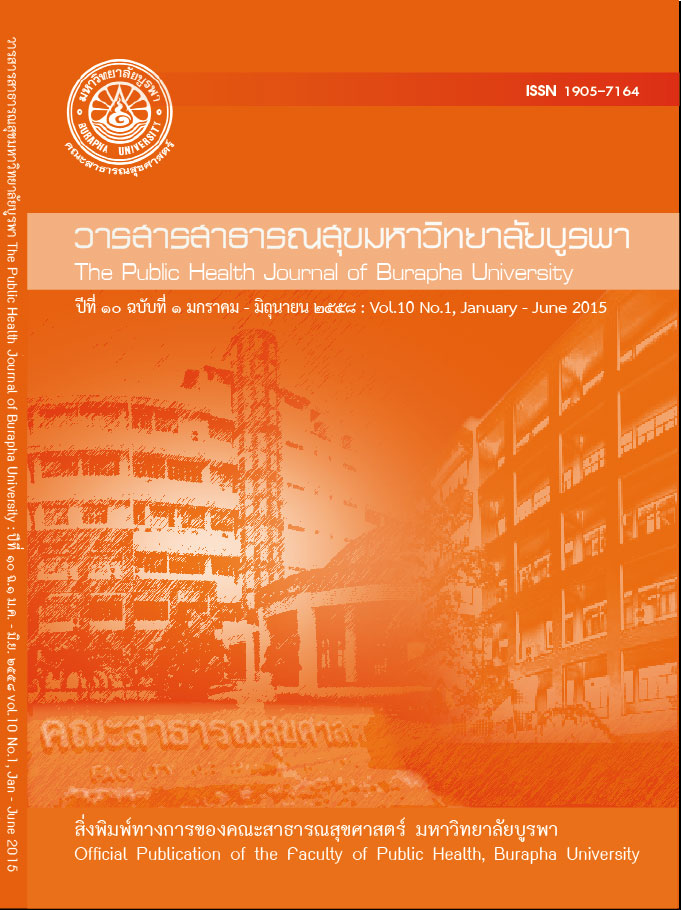Strategies for Development of the Tuberculosis Control Program in Tak Province
Main Article Content
บทคัดย่อ
การพัฒนากลยุทธ์การดำเนินงานควบคุมวัณโรคในพื้นที่จังหวัดตาก
กิตติพัทธ์ เอี่ยมรอด, สุพร กาวินำ
สำนักงานสาธารณสุขจังหวัดตาก
การวิจัยนี้มีวัตถุประสงค์เพื่อ 1) ศึกษาสภาพและปัญหาการดำเนินงานวัณโรค 2) พัฒนากลยุทธ์ การดำเนินงานควบคุมวัณโรค 3) ประเมินกลยุทธ์การดำเนินงานควบคุมวัณโรคในพื้นที่จังหวัดตาก โดยดำเนินการวิจัยเป็น 3 ขั้นตอน ได้แก่ ขั้นตอนที่ 1 การศึกษาสภาพและปัญหาการดำเนินงาน วัณโรคในพื้นที่จังหวัดตากประกอบด้วย การศึกษาเอกสารเกี่ยวกับการดำเนินงานควบคุมวัณโรค ในจังหวัดตาก การสัมภาษณ์การสนทนากลุ่ม ประชุมอภิปรายกลุ่ม ขั้นตอนที่ 2 การพัฒนากลยุทธ์ การดำเนินงานควบคุมวัณโรคในพื้นที่จังหวัดตาก โดยการประชุมเชิงปฏิบัติการ ขั้นตอนที่ 3 การ ประเมินกลยุทธ์โดยผู้ทรงคุณวุฒิวิเคราะห์ข้อมูลโดยคำนวณร้อยละ ค่าเฉลี่ย ค่าเบี่ยงเบนมาตรฐาน และการวิเคราะห์เนื้อหา
ผลการศึกษา พบว่า ระบบการดูแลผู้ป่วยวัณโรคในปัจจุบันที่ยังไม่เอื้อต่อการเข้าถึงบริการ ได้แก่การให้ความรู้ที่จำเป็นแก่ผู้ป่วยยังไม่ครอบคลุม ขาดการประเมินผลหลังให้ความรู้แก่ผู้ป่วย ระบบการติดตามเยี่ยมบ้านโดยเจ้าหน้าที่รพ.สต. และทีมงานยังไม่ครอบคลุม กลยุทธ์การพัฒนาการ ดำเนินงานควบคุมวัณโรคในพื้นที่จังหวัดตากที่พัฒนาขึ้นมีทั้งหมด 6 กลยุทธ์19 ตัวชี้วัด ผลการ ประเมินการพัฒนากลยุทธ์ฯ พบว่ากลยุทธ์ส่วนใหญ่ มีความสอดคล้องในระดับมากที่สุด ความ เหมาะสมในระดับมาก ความเป็นไปได้ในระดับมาก และมีประโยชน์ในระดับมากที่สุด
การพัฒนากลยุทธ์ที่สอดคล้องกับสภาพความพร้อมและบริบทของหน่วยงาน ควรเน้นให้มี การจัดทำข้อมูลสภาพและปัญหาการดำเนินงานด้วยการเก็บรวบรวมข้อมูลเชิงคุณภาพด้วย การ สัมภาษณ์เจาะลึกสนทนากลุ่ม และการอภิปรายกลุ่มของผู้ป่วย ผู้ปฏิบัติงานที่เกี่ยวข้องในทุกระดับ รวมถึงการจัดให้มีการเรียนรู้ด้านพุทธิพิสัย จิตพิสัย และทักษะพิสัย แก่ผู้มีส่วนร่วมในการวางแผน กลยุทธ์และจัดให้มีการประเมินกลยุทธ์ที่ได้พัฒนาขึ้น
The purposes of the research were: 1) to study the situations and problems of the tuberculosis control program in Tak Province; 2) to develop strategies for the tuberculosis control program in Tak Province; 3) to evaluate the results of the developed strategies in Tak Province. The study consisted of three phases: first, collecting the data by using a questionnaire, reviewing the related literatures,
conducting in-depth interviews, and holding focus-group discussions; second, developing strategies for the tuberculosis control program in Tak Province by overseeing a workshop with the Health Planning and Evaluation Committee; and third, assessing the strategies with 15 experts. The data was analyzed by using percentage, standard deviation and consent analysis. The findings were as follows: some of the patients were not able to access the TB care system, and so they didn’t understand the information about TB, and when they were given information about TB, there wasn’t any post evaluation to determine if they understood the information or not. Also, a problem was that the public health provider team didn’t always implement all of the six strategies and 19 indicators. Overall, it was found that of the strategies, the implementation and benefits were the highest score, and the appropriateness and feasibility were a high score. The strategies which were developed should emphasize the readiness and preparedness of the health care facilities to respond to the TB patients. They should pay special attention to the data base of the situations and problems of the TB control program. To produce the data base, they should conduct qualitative data collection, such as in-depth interviews and focus group discussions with the TB patients. The learning activities should include knowledge, attitude and skills so the participants who are involved in the strategy planning will be able to evaluate the strategies that were developed.

